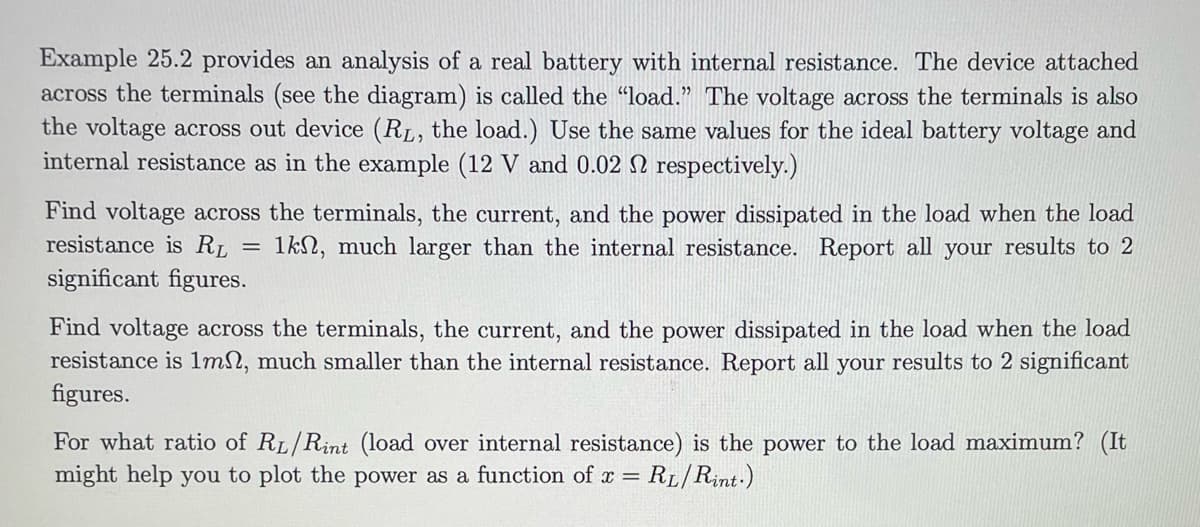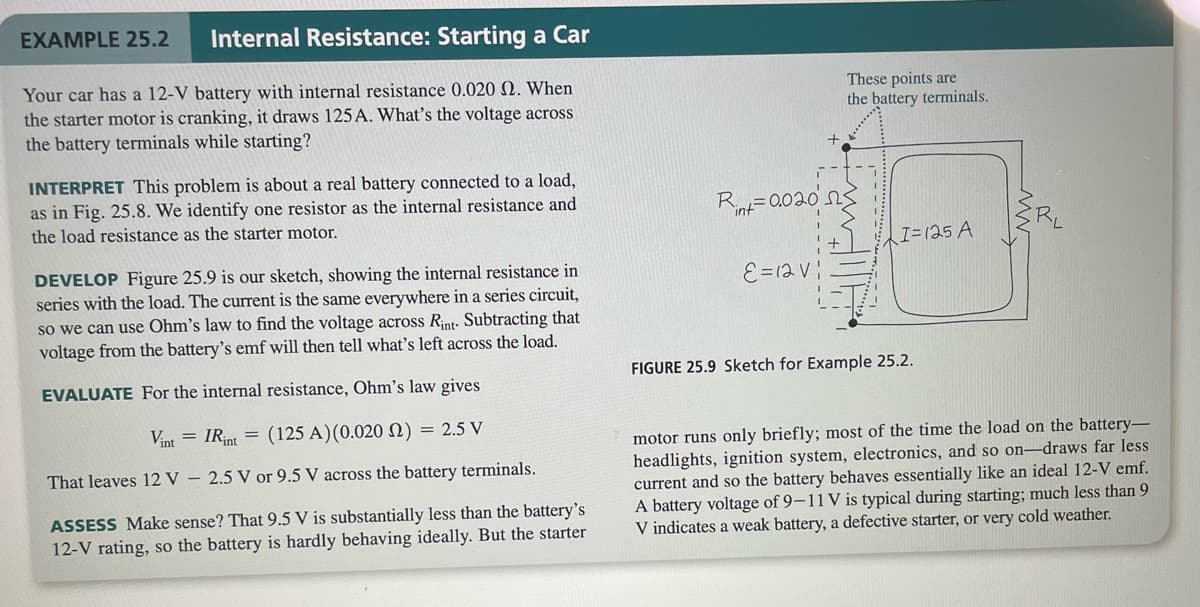Internal Resistance: Starting a Car Your car has a 12-V battery with internal resistance 0.020 2. When the starter motor is cranking, it draws 125 A. What's the voltage across the battery terminals while starting? EXAMPLE 25.2 INTERPRET This problem is about a real battery connected to a load, as in Fig. 25.8. We identify one resistor as the internal resistance and the load resistance as the starter motor. DEVELOP Figure 25.9 is our sketch, showing the internal resistance in series with the load. The current is the same everywhere in a series circuit, so we can use Ohm's law to find the voltage across Rint. Subtracting that voltage from the battery's emf will then tell what's left across the load. EVALUATE For the internal resistance, Ohm's law gives Vint = IRint (125 A)(0.020 2) = 2.5 V That leaves 12 V - 2.5 V or 9.5 V across the battery terminals. ASSESS Make sense? That 9.5 V is substantially less than the battery's 12-V rating, so the battery is hardly behaving ideally. But the starter Rint=0.020 ε =12 Vi These points are the battery terminals. I=125 A FIGURE 25.9 Sketch for Example 25.2. motor runs only briefly; most of the time the load on the battery- headlights, ignition system, electronics, and so on-draws far less current and so the battery behaves essentially like an ideal 12-V emf. A battery voltage of 9-11 V is typical during starting; much less than 9 V indicates a weak battery, a defective starter, or very cold weather.
Internal Resistance: Starting a Car Your car has a 12-V battery with internal resistance 0.020 2. When the starter motor is cranking, it draws 125 A. What's the voltage across the battery terminals while starting? EXAMPLE 25.2 INTERPRET This problem is about a real battery connected to a load, as in Fig. 25.8. We identify one resistor as the internal resistance and the load resistance as the starter motor. DEVELOP Figure 25.9 is our sketch, showing the internal resistance in series with the load. The current is the same everywhere in a series circuit, so we can use Ohm's law to find the voltage across Rint. Subtracting that voltage from the battery's emf will then tell what's left across the load. EVALUATE For the internal resistance, Ohm's law gives Vint = IRint (125 A)(0.020 2) = 2.5 V That leaves 12 V - 2.5 V or 9.5 V across the battery terminals. ASSESS Make sense? That 9.5 V is substantially less than the battery's 12-V rating, so the battery is hardly behaving ideally. But the starter Rint=0.020 ε =12 Vi These points are the battery terminals. I=125 A FIGURE 25.9 Sketch for Example 25.2. motor runs only briefly; most of the time the load on the battery- headlights, ignition system, electronics, and so on-draws far less current and so the battery behaves essentially like an ideal 12-V emf. A battery voltage of 9-11 V is typical during starting; much less than 9 V indicates a weak battery, a defective starter, or very cold weather.
Physics for Scientists and Engineers, Technology Update (No access codes included)
9th Edition
ISBN:9781305116399
Author:Raymond A. Serway, John W. Jewett
Publisher:Raymond A. Serway, John W. Jewett
Chapter28: Direct-current Circuits
Section: Chapter Questions
Problem 28.59AP: A rechargeable battery has an emf of 13.2 V and an internal resistance of 0.850 . It is charged by a...
Related questions
Question

Transcribed Image Text:Example 25.2 provides an analysis of a real battery with internal resistance. The device attached
across the terminals (see the diagram) is called the "load." The voltage across the terminals is also
the voltage across out device (RL, the load.) Use the same values for the ideal battery voltage and
internal resistance as in the example (12 V and 0.02 2 respectively.)
Find voltage across the terminals, the current, and the power dissipated in the load when the load
resistance is RL 1k, much larger than the internal resistance. Report all your results to 2
significant figures.
=
Find voltage across the terminals, the current, and the power dissipated in the load when the load
resistance is 1m, much smaller than the internal resistance. Report all your results to 2 significant
figures.
For what ratio of RL/Rint (load over internal resistance) is the power to the load maximum? (It
might help you to plot the power as a function of x = = RL/Rint.)

Transcribed Image Text:Internal Resistance: Starting a Car
Your car has a 12-V battery with internal resistance 0.020 2. When
the starter motor is cranking, it draws 125 A. What's the voltage across
the battery terminals while starting?
EXAMPLE 25.2
INTERPRET This problem is about a real battery connected to a load,
as in Fig. 25.8. We identify one resistor as the internal resistance and
the load resistance as the starter motor.
DEVELOP Figure 25.9 is our sketch, showing the internal resistance in
series with the load. The current is the same everywhere in a series circuit,
so we can use Ohm's law to find the voltage across Rint. Subtracting that
voltage from the battery's emf will then tell what's left across the load.
EVALUATE For the internal resistance, Ohm's law gives
Vint = IRint
(125 A)(0.020 2) = 2.5 V
That leaves 12 V - 2.5 V or 9.5 V across the battery terminals.
ASSESS Make sense? That 9.5 V is substantially less than the battery's
12-V rating, so the battery is hardly behaving ideally. But the starter
Rint=0.020
ε =12 Vi
These points are
the battery terminals.
I=125 A
FIGURE 25.9 Sketch for Example 25.2.
motor runs only briefly; most of the time the load on the battery-
headlights, ignition system, electronics, and so on-draws far less
current and so the battery behaves essentially like an ideal 12-V emf.
A battery voltage of 9-11 V is typical during starting; much less than 9
V indicates a weak battery, a defective starter, or very cold weather.
Expert Solution
This question has been solved!
Explore an expertly crafted, step-by-step solution for a thorough understanding of key concepts.
Step by step
Solved in 2 steps with 1 images

Follow-up Questions
Read through expert solutions to related follow-up questions below.
Knowledge Booster
Learn more about
Need a deep-dive on the concept behind this application? Look no further. Learn more about this topic, physics and related others by exploring similar questions and additional content below.Recommended textbooks for you

Physics for Scientists and Engineers, Technology …
Physics
ISBN:
9781305116399
Author:
Raymond A. Serway, John W. Jewett
Publisher:
Cengage Learning

College Physics
Physics
ISBN:
9781938168000
Author:
Paul Peter Urone, Roger Hinrichs
Publisher:
OpenStax College


Physics for Scientists and Engineers, Technology …
Physics
ISBN:
9781305116399
Author:
Raymond A. Serway, John W. Jewett
Publisher:
Cengage Learning

College Physics
Physics
ISBN:
9781938168000
Author:
Paul Peter Urone, Roger Hinrichs
Publisher:
OpenStax College


Physics for Scientists and Engineers with Modern …
Physics
ISBN:
9781337553292
Author:
Raymond A. Serway, John W. Jewett
Publisher:
Cengage Learning

Physics for Scientists and Engineers
Physics
ISBN:
9781337553278
Author:
Raymond A. Serway, John W. Jewett
Publisher:
Cengage Learning

Principles of Physics: A Calculus-Based Text
Physics
ISBN:
9781133104261
Author:
Raymond A. Serway, John W. Jewett
Publisher:
Cengage Learning